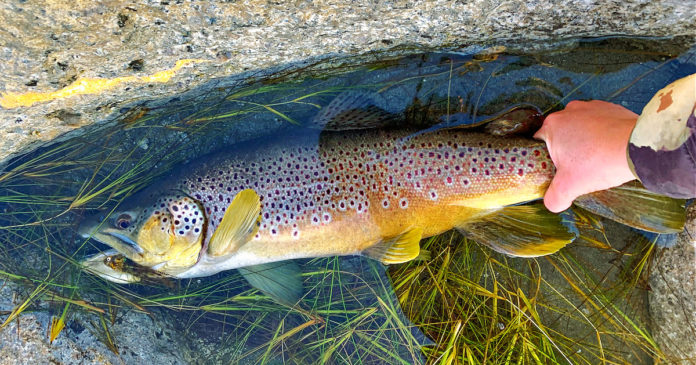From working longer hours in search of promotion to practicing with your rifle or bow at the range, we’re all constantly in search of a way to up our game. While much of the time reaching the next tier in our jobs, hobbies, or passions requires hours of hard work and dedication to our craft, on occasion, it’s helpful to have a bit of guidance. A sort of cheat code that points us in the right direction and gives us a jumping-off point to break the proverbial champagne bottle against before launching on our newest journey. Never is this more helpful in the world of fly fishing for trout than when you first start fishing with streamers.
Streamer fishing is difficult for many anglers to get into because it goes against the conventional ideas of fly fishing. It requires heavier equipment, nearly constant movement of your fly, and above all else, understanding how and when to fish large, gaudy fly patterns.
The variety of streamer flies and the different actions and plethora of colors that they have can be incredibly intimidating. You may feel that you have to have two or three of every size, shape, and color in order to be successful. But I’ve found that when it comes to catching big trout on streamers, your best bet is to take a “less is more” approach. In fact, I carry only 10 patterns with me when I’m streamer fishing. Ten patterns will cover me in almost every fishing situation and are all you need to find and catch big trout out on the water.
The Wooley Bugger
Classics become classics for a reason, and in the case of the Wooley Bugger it’s because it works. Developed by fly angler Russell Blessing in the late 1960s, Wooley Buggers can be used under a strike indicator to imitate leeches, stripped through the water like a small baitfish, or simply dead drifted or even trolled in still-water and along riverbanks from a boat where they represent things like damsel fly larvae and large stoneflies.
“I love the Wooley Bugger because it works everywhere and for everything basically,” says professional trout guide James Mugele of Sweetwater Fly Shop in Livingston, Montana. “They’re such old school patterns and so simple and incredibly easy to tie. Whenever I’m stuck out there on the water and don’t know what to do, I’ll tie on a black Wooley bugger because they’ll always put trout in the net, even on the toughest days.”
The Clouser Minnow
The Clouser Minnow is a very basic baitfish pattern that can catch trout at almost any time of the year in a variety of different types of water. Originally devised by Bob Clouser in the late 1980s for use on both saltwater and in the famous spring creeks and limestone creeks of Pennsylvania, Clouser Minnow’s can be stripped and swung through fast water, jigged through deep pools, or smacked down and twitched like a dead or dying baitfish in lakes and ponds.
Their upside-down hook design means that they’re difficult to get snagged in the rocks or weeds along the bottom, and their simple design and inexpensive price mean that you can easily tie or buy more anyway if you do.
The Sex Dungeon
Sometimes your best bet for catching a big trout is to jig them up, and for that, nothing beats a Sex Dungeon. Originally developed by famous streamer junkie Kelly Galloup, the Sex Dungeon is made up of a little bit of everything that big trout like. With its heavy lead eyes and bulky deer hair head and lighter marabou body, the fly sinks fast and is the perfect bug to be cast out and jigged with fast strips and a twitching rod tip tantalizingly along the bottom or off structure where it will be inhaled by an otherwise reluctant predatory trout.
“I like the Sex Dungeon because I think that deer hair head gets sluggish trout to be aggressive,” said Mugele, who uses the Sex Dungeon frequently to catch the monster trout hiding in the Yellowstone River. “It’s a fly that will get them moving on hot or cold days when they’re hesitant to chase stuff down and what’s more if you fish it in bright colors like yellow or white, you’ll be able to see it in the water at least for the first couple strips, which is usually when it gets slammed.”
Mike’s Meal Ticket
When you’re fishing high or discolored water and the trout are pushed against the bank, you want a fly with a big profile that you can fish easily and will get a quick reaction from the fish and nothing is better for that than Mike’s Meal Ticket. Invented by Mike Schmidt this largish streamer comes with heavy dumbbell eyes, rubber legs, and a lot of flash, yet has a sleek and easy-to-see profile as soon as it hits the water.
It’s the perfect pattern to smack down along undercut banks, pitch under bushes, and drop in around big boulders and log jams. Twitch it a few times and if it doesn’t get absolutely smashed, move on to the next spot.
The Double Deceiver
When I’m fishing a big river and need to cover a lot of water quickly, the Double Deceiver is my go-to fly. Essentially a beefed-up classic Deceiver fly, the DD is a large baitfish pattern made up of two large hooks and a bucktail body with a long, schlappen feather tail. This brilliant pattern is neutrally buoyant, meaning that it only sinks a few feet below the surface, and has a long and very realistic profile as well as a very lifelike swimming action.
The Double D can be stripped and twitched back to the boat like a jerkbait or simply dead drifted across long pools or along undercut banks. The light materials mean it casts easily and at great distances and when fished on a sink-tip, it becomes the ultimate weapon for finding big fish on big water.
The Zonker
When you’re hunting small streams for big, baitfish-loving trout or find yourself in fast water and need a fly that can be fished quickly along small pockets and buckets in rapids, there’s no better fly for the task than the Zonker. Invented by Dan Byford, a Colorado-based fly angler in 1975, the Zonker consists of a long strip of rabbit fur attached to a small compact flashy body made of mylar.
It’s a simple but effective pattern that is the perfect imitation for a myriad of small baitfish, from sculpins, minnows, and smelt to baby trout and whitefish. The pattern’s realistic action and flashy profile attracts a lot of attention and makes it the perfect fly for ripping through fast water or swinging down along the tail outs of pools. Places where trout will be more than willing to dash out from cover and engulf it.
The Sluggo and The Big Johnson
Sometimes a big fish will simply chase and roll on your streamer without actually striking it. Like a tough guy flexing at you in a bar, they often need a little extra irritation before they truly commit to the fight. This is where the Sluggo and Big Johnson truly shine. Invented by Chad Johnson who guides for trout on the fabled waters of the White River in Cotter, Arkansas both patterns have a long double articulated body that presents an appealing and meaty profile for a big hungry trout. The real magic though is in the flies’ heads which are made of stacked deer hair. The flies are unweighted and designed to be fished on a sinking line. When stripped, the thick heads of the flies turn the fly sharply sideways in the water, offering pursuing trout a broadside shot.
“Fishing these flies on a sinking line with the line trying to pull the fly down and the deer hair trying to float up creates a struggle,” Chad Johnson told Meat Eater. “When the line and material are fighting with each other they create a really nice 90-degree angle every time you stop stripping the fly. This is a kill shot for a predator fish. I feel like if I create as many kill shots as possible on the fly’s way in, I’m making opportunities for that fish to T-bone the fly. I’ve seen over the years that presenting more kill shots, equals more kill shots.”
Sculpzilla and The Dolly Llama
Sometimes you just have to go deep. On hot days when trout are seeking out cooler, more oxygenated water or are moving into their winter-holding areas, the fish are reluctant to move out of deep water to feed. So, your best bet is to use streamer patterns that sink fast and can quickly get to where the fish are hiding. No other streamers work better for this than the Sculpzilla and the Dolly Llama.
Both flies can either be jigged, stripped, or swung in deep water where they will trigger a leviathan into feeding. According to master fly fishing guide Chris Gerano, who uses these flies for monster deep-dwelling trout in rivers around Idaho, Colorado, Montana, and Oregon, the Sculpzilla and the Dolly Llama are especially effective because they have so many uses.
“I use the Sculpzilla and the Dolly Llama specifically because they have giant cones on their heads and when I’m trying to fish anything that looks like a wounded fish or like a sculpin, I want them to be on the bottom,” Gerano said. “The sculpizilla is a good sculpin pattern for both stripping and also for high stick nymphing as it doesn’t just act as a streamer but also as an attractor. I can run the fly along the bottom with a dropper under an indicator. Big trout will either eat the streamer or be attracted in close enough by it to eat the nymph or whatever I’m using as a dropper.”
Gerano likes to use the Dolly Llama in the same way, but he also used it when he is targeting any extra-large fish that may be hiding along drop-offs or in deep holes.
“The dolly is not a tiny fly,” Gerano told Meat Eater. “It’s typically a 4- to 6-inch long fly, and if I’m specifically targeting larger fish, it’s a fly that will get down there and get noticed. The Dolly is a great streamer that will get down quickly even with a floating line, and it swings really well because it won’t get pulled up to the surface in fast current or get tangled. The rabbit strips on the fly also provide some great action with very little effort.”
Taking It to the Next Level
I’ve always considered streamer fishing to be the true upper echelon of the fly fishing world. It doesn’t have the same graceful appeal as dry fly fishing, nor is it a way to catch a lot of trout quickly like nymphing.
It’s a dirty, rough, finger-burning, shoulder-wearing way to fish but if you want to catch that giant trout you’ve always dreamed about, then streamer fishing is the only way to go. So don’t get bogged down in trying to find the right streamer for the job, because the 10 flies on this list can do it all and are more than enough to help you step up and take your fly fishing game to the next level.
Feature image via Maggie Hudlow.
Credit: Source link































